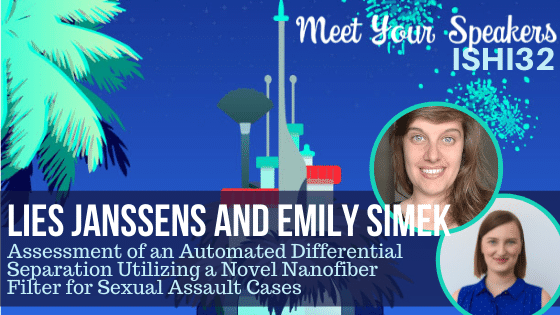Automated and semi-automated sample processing has become more widespread with the implementation of various robotic platforms. A new robotic application for differential separation of sexual assault samples using a novel nanofiber filter was evaluated for a high-throughput laboratory system.
At their presentation this year, Lies Janssens and Emily Simek will be presenting on a high-throughput sample processing system to eliminate the years-long sexual assault kit backlog established by The Utah Bureau of Forensic Services (UBFS). Like many test-all states, UBFS is looking to continue to improve current workflows to keep pace with the number of cases submitted. Although most automated DNA laboratory processes used at UBFS accommodate ninety-six samples at a time, one area where capacity and efficiency could be improved is the differential separation process.
We chatted with Lies and Emily about the role nanofiber technology plays, how automating the differential separation process allows for cases to be processed quicker, and how a conversation at ISHI sparked the project.
I noticed in Lies’ biography that this project started based on a conversation at ISHI in Phoenix. Can you tell me more?
During ISHI in Phoenix, I was browsing the poster presentations during one of the exhibitor’s breaks and came across a poster titled “Novel Y-Screening and SpermTrap Differential Extraction: Streamlined Sexual Assault Kit Processing”. I started talking to Sudhir Sinha and he informed me that they were looking for a laboratory that had a Hamilton AutoLys to collaborate with. I immediately contacted my DNA technical leader and she approved the collaboration with InnoGenomics Technologies Inc., to validate the SpermX device for automation utilizing the Hamilton AutoLys.
How does automating the differential separation process allow for cases to be processed quicker? How long does it take to complete this step using traditional methods? How much time is saved when it is automated?
By automating the differential separation process there is less analyst sample handling and hands-on time. It also allows 96 samples to be processed in a single run versus multiple semi-automated runs or multiple manual separations.
Using our current semi-automated method, processing 72 samples takes about 7 hours, with a little over 5 hours of hands-on time; this translates into over 12 hours of analyst hands-on time for 192 samples. Compared to the fully automated method, which takes about 13.5 hours for 192 samples, with only 4 hours of analyst hands-on time. So, generally speaking, you save about 8 hours of analyst’s time.
What role does the nanofiber technology play? What makes it uniquely suited for this purpose?
The role of the nanofiber technology is to trap the spermatozoa while non-sperm cells flow through, allowing for a single tube differential separation. Both non-sperm and sperm fractions are collected after incubations with different reagents.
Is this process something that other forensic laboratories could easily employ? What tools/training are needed?
If a forensic laboratory has a Hamilton AutoLys, it would be possible and easy to implement this new automated method. The end product is lysate, so it can be modified to any downstream extraction method.
Instrument setup, reagent preparation, and understanding the protocol and method would be the only training requirements, aside from the laboratory’s preferred extraction method.
What tips would you give to someone who is just starting out in the field of forensics, or what is the best advice that you’ve received?
- Be open to change because forensic science is an ever-evolving field.
- Own up to your mistakes, and don’t be afraid to ask questions.
- If you have a passion for forensics, keep up with it.
Has there been anything good that came out of the pandemic that you’ll continue doing going forward?
We have a bigger appreciation for our health as well as our coworkers. Working from home, although nice, made us miss our inter-office relationships.
What is your favorite Disney character and why, or which Disney character do you most relate to and why?
Emily: WALL-E (from “WALL-E”). I like that he is optimistic, curious, and he really cares about plants. He is a plant hobbyist just like me.
Lies: Belle (from “Beauty and the Beast”). I like that she is independent, smart, and adventurous. The movie is set in France, and that just reminds me of my childhood in France.
If you could have one superpower, what would it be and why?
Emily: the ability to fly because I hate traffic especially rush hour.
Lies: the ability to teleport because it would cheaper and easier to see my family and friends overseas.
What’s one thing that others may not know about you?
Emily: My free-lance makeup work was published in Utah’s “Rocky Mountain Bride” magazine.
Lies: I was a flautist and backing vocalist in a Jazz band named “Tourist in Paradise”.
WOULD YOU LIKE TO SEE MORE ARTICLES LIKE THIS? SUBSCRIBE TO THE ISHI BLOG BELOW!
SUBSCRIBE NOW!


